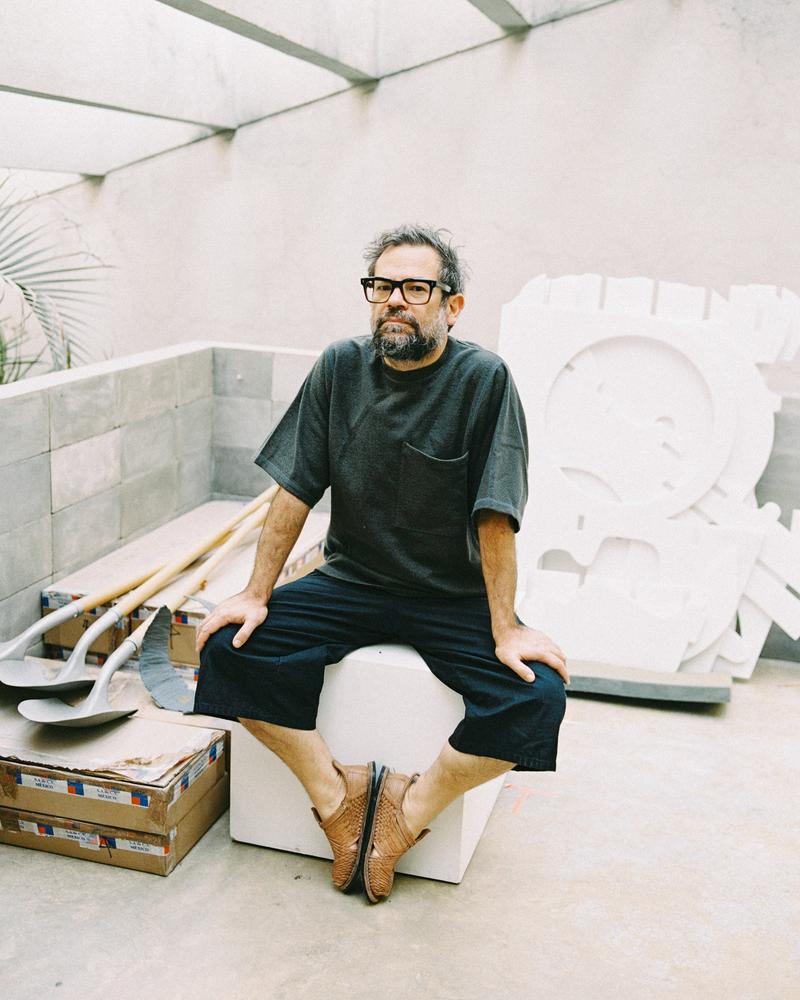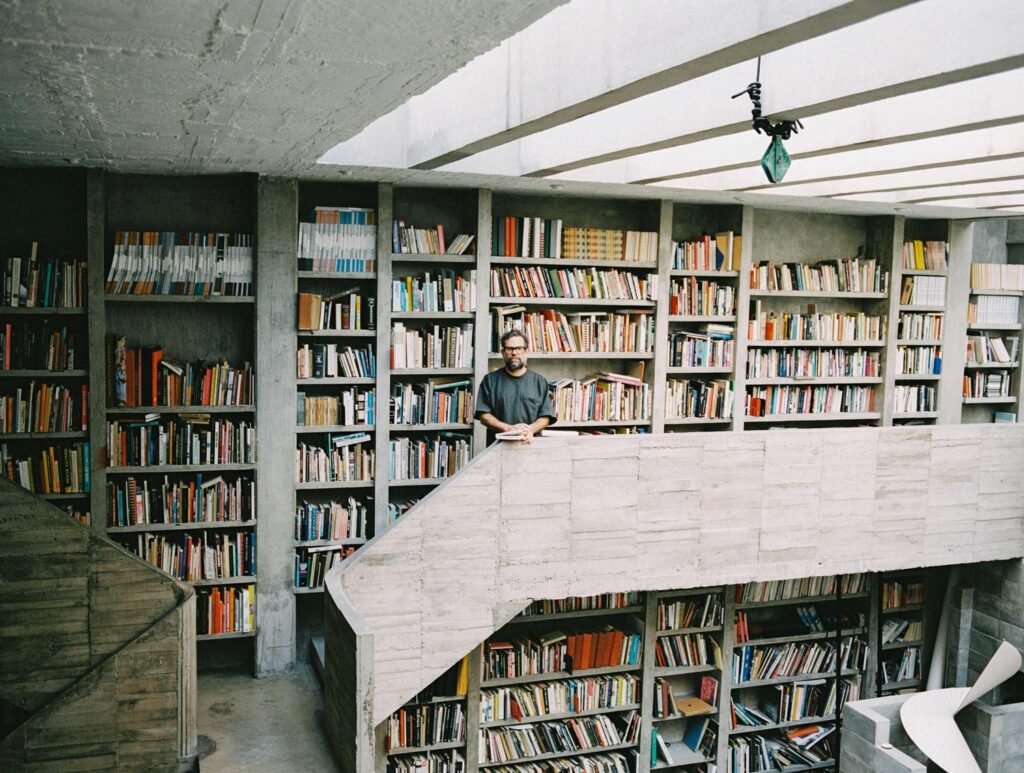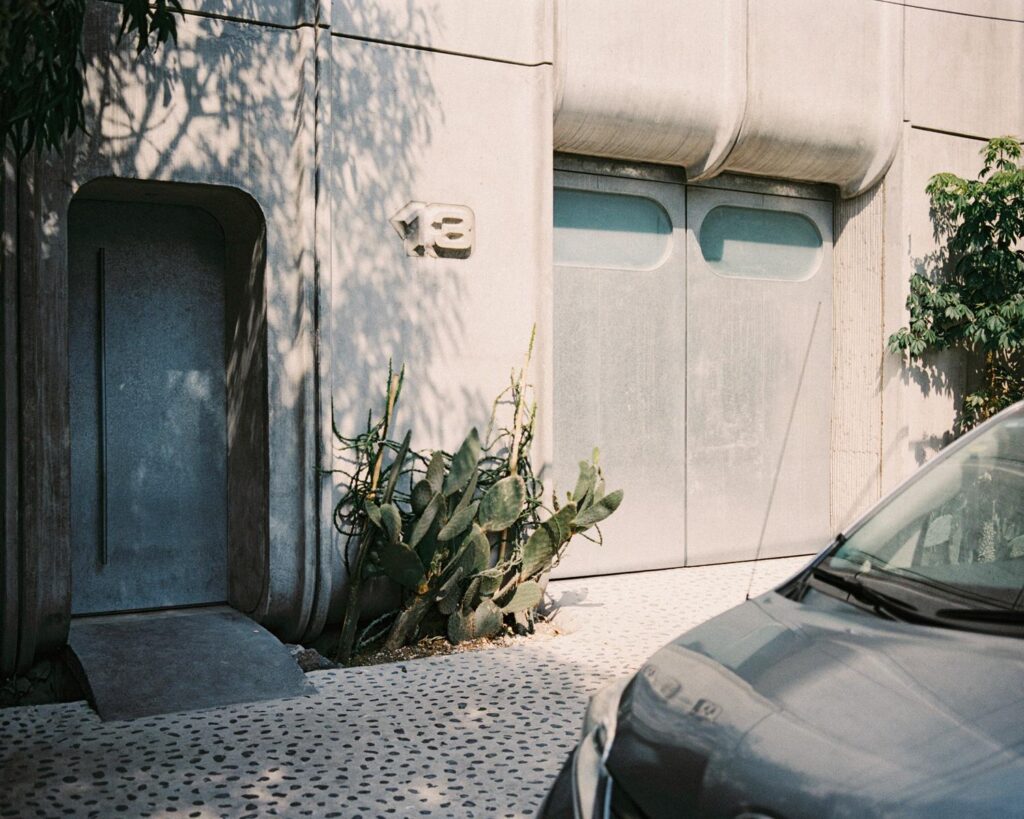“IN A MEXICAN SPACESHIP. A CONVERSATION WITH PEDRO REYES” ARTICLE
PUBLISHED ON VOGUE SPAIN · PHOTOGRAPHY IRIS HUMM · MEXICO CITY, 2020
IN A MEXICAN SPACESHIP: A CONVERSATION WITH PEDRO REYES
Spanish Only
If you should happen to be in Mexico City, walking through the neighbourhood of Coyoacán, you may stumble across what appears to be a pre-hispanic spaceship. This brutalist gem is the concrete compound where Pedro Reyes, one of Mexico’s most renowned contemporary artists, lives and works.
As the hatch opens up, a man dressed in a light grey jumpsuit, akin to that of a factory worker, welcomes us in. Passing through a large shared courtyard, we step into the library, the core of a multi-level live/work space that includes a stone carving workshop, metalworking and welding facilities, a wood shop, a private studio, offices, a small living space for visiting artisans, and of course the private residence that Reyes shares with his wife, fashion designer Carla Fernandez. A laboratory, a factory, a home. As I stand in wonder in the center of this space, my eyes exploring the recesses of stone and concrete and an impressive collection of books.
Though he is perhaps most recognized for his sculptural works, Pedro’s practice in fact spans numerous other mediums including installations, drawing, theatre, music and sound art, and social activism, with commissions from the likes of the Guggenheim Museum in New York, Whitechapel Gallery in London, and the ICA Miami. In between, he has found time to lecture at the Massachusetts Institute of Technology. The 50 year-old artist likes to describe himself as a ‘cavemen of the future.’ As he enters the room, his clothes covered in the dust from sanding his most recent volcanic stone sculpture, the description seems more than apt.
The 50-years-old artist likes to define himself as a ‘cavemen of the future’.
“Sorry, I’m all dirty. Shall I serve you some coffee while I go and change?” This is not my first time at Pedro’s place — I first came here during one of those late-night get-together he is known to throw periodically— but I take advantage of Pedro’s momentary absence to wander. It’s Monday morning. Throughout the complex I sense the presence of workers, designers, assistants, cooks, photographers. The place is nonetheless immersed in a palpable, solid silence. It’s almost as if the beauty of the space has muffled every sound, with every noise being suppressed by the concrete walls and every conversation drowned out by the natural light inundating the space from above. “The light here constantly changes, all day long” he says, reappearing in the library.
Pedro was originally trained as an architect, but his work moved towards the more multi-disciplinary art practice as he founded the Torre de los Vientos. And by ‘founded’, I mean that he broke the lock of the eponymous structure by renowned Uruguayan sculptor Gonzalo Fonseca, built for the Olympic Games in 1968 but largely neglected in the decades to follow, and occupied the space. Transforming it, from 1996 to 2002, into a dynamic cultural space supported by the government which has hosted installations and exhibitions from the likes of Mauricio Rocha, Enrique Jezik, Santiago Sierra, Gustavo Artigas, Julieta Aranda, Tsuyoshi Ozawa, Robert Chambers, and Claudia Fernández. Through this experience, Pedro’s profile shifted towards that of a contemporary artist, and his sculpture, video and performance pieces, often addressing social and political issues, began to garner international attention.
“For every gun there’s a shovel. And with every shovel, we planted a tree.”
For the 2009 Lyon Biennale, he collected over 1,500 guns presumably seized from narcos from the Mexican government and melted them down to produce shovels. “For every gun there’s a shovel. And with every shovel, we planted a tree.” A couple of years later, in Disarm (2013), he obtained 6,700 guns that had been confiscated from criminal gangs and turned them into playable musical instruments. For The Permanent Revolution (2014) and Manufacturing Mischief (2017), he created satirical puppet plays addressing the darker side of techno-enthusiasm. The play featured characters like Elon Musk, Marx, Adam Smith, Trotsky or Noam Chomsky, met during Pedro’s times as Distinguished Visiting Artist at MIT. Apparently, one the world’s most known intellectual was very pleased to be the protagonist puppet. But what’s so bad about tech? “We should stop considering tech as a moral category, as if tech itself would means progress. I believe in the idea of de-growth, or at least the idea of really using tech really for the greater good. I describe myself as a cyber-Marxist.”
“The hardest thing is to create a beautiful object without any function that is still able to justify its existence.”
While all of these projects stand for something, it would be a mistake to assume that all of Pedro’s work is political. “One of the most beautiful things is the pointlessness of art. A profound need of the human is to be able to create something just for that thing’s sake”. He seems to understand most of the things he designs using mainly two distinct ontological categories: sculptures with a function, and those without. “When I work on sculptures with a function, like a chair for instance, in my mind there are a series of limits, needs to fulfil, and problems to solve. But the hardest thing is to create a beautiful object without any function that is still able to justify its existence.”
Pedro is deeply interested in the semantics of objects: not just in how we shape them, but also how they shape us. In his latest exhibition, Esculturas Habitables, Reyes explores more functional sculptures, offering a series of furniture, living models, buildings, and objects driven by a sort of Ethno-Futurism, a form to imagine a future in which pre-hispanic aesthetics and constructive systems are implemented in the contemporary world. “The history of architecture and art is built upon European and North American ideals, in a way that has discursively and aesthetically monopolised any other cultural production.” For , retrieving these roots by creating a new sculptorical language stemming from Mesoamerican culture can help to bypass the cultural colonisation perpetrated in Central America: “Creating these new series of relationships is a way to circumvent the prevailing Western culture and decolonise our future.”
(continues…)
Published on Vogue Living, May 2020
Thanks to Iris Humm and Óscar Germade
* *
*


